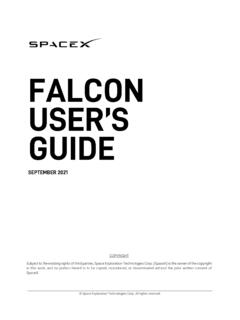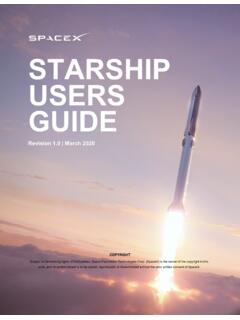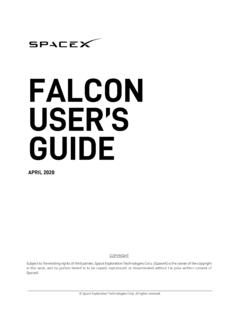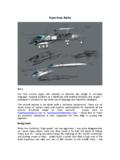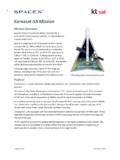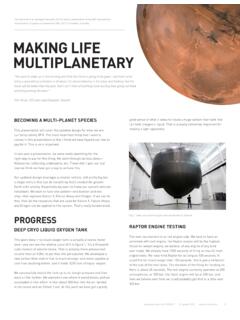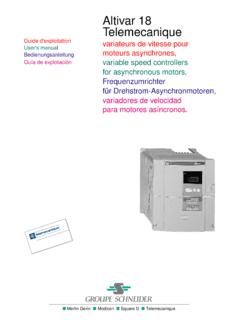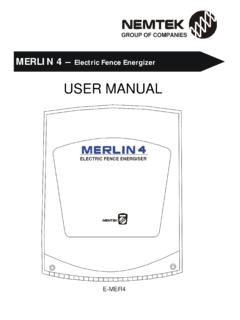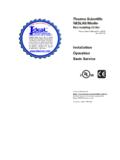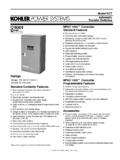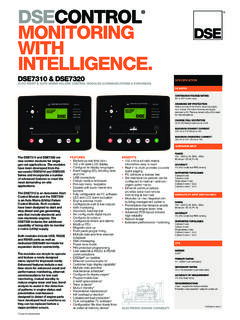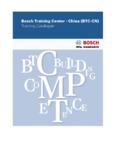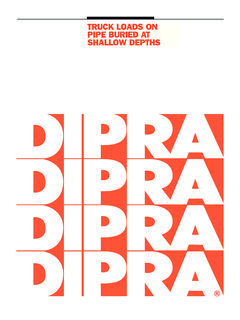Transcription of Falcon 9 Users Guide rev02 - SpaceX
1 October 21st, 2015 Falcon 9 Launch Vehicle PAYLOAD user S GUIDERev 2 Approved for Public ReleaseCleared for Open Publication by Office of Security user s Guide Revision 2 2015 Space Exploration Technologies Corp. All rights reserved. 2 TABLE OF CONTENTS 1. Introduction 5 user s Guide Purpose 5 Company Description 5 Falcon Program Overview 6 Falcon Launch Vehicle Safety 6 Falcon Reliability 7 Pricing 9 2. Vehicles 10 Falcon 9 Vehicle Overview 10 Structure and Propulsion 10 Retention, Release and Separation Systems 12 Avionics, and Guidance, Navigation and Control 12 Coordinate Frame 12 3. Performance 14 Available Injection Orbits 14 Mass-to-Orbit Capability 14 Mass Properties 15 Launch Windows 16 Flight Attitude 16 Orbit Insertion Accuracy 16 Separation Attitude and Accuracy 16 Multiple Payloads 17 Secondary Payloads 17 4.
2 Environments 18 Transportation Environments 18 Temperature, Humidity and Cleanliness 18 Flight Environments 19 Loads 19 Sine Vibration 21 Acoustic 23 Shock 26 Radio Frequency 27 Fairing Internal Pressure 30 Payload Temperature Exposure during Flight 31 Free Molecular Heating 32 Environmental Compatibility Verification 32 5. Interfaces 34 Mechanical Interfaces 34 Payload Adapters and Separation Systems 34 Payload Fairing 36 Falcon user s Guide Revision 2 2015 Space Exploration Technologies Corp. All rights reserved. 3 Electrical Interfaces 37 Connectivity during Payload Processing and on Launch Pad 37 Falcon -to-Payload Command Interface 39 Timing Services 40 Interface Compatibility Verification Requirements 40 6.
3 Facilities 41 Cape Canaveral Air Force Station, Florida 41 CCAFS Personnel Accommodations 41 Vandenberg Air Force Base, California 43 VAFB Personnel Accommodations 44 Headquarters Hawthorne, CA 46 Rocket Development Facility McGregor, TX 47 Government Outreach and Legal Affairs Washington, DC 47 7. Mission Integration and Services 48 Contracting 48 Mission Management 48 Standard Services 49 Schedule 50 Customer Deliverables 51 8. Operations 53 Overview and Schedule 53 Spacecraft Delivery and Transportation 53 Spacecraft Processing 54 Joint Operations and Integration 57 Launch Operations 58 Organization 58 Spacecraft Control Center 59 Launch Control 59 Rollout, Erection and Pad Operations 60 Countdown 60 Recycle and Scrub 60 Flight Operations 61 Liftoff and Ascent 61 Spacecraft Separation 61 Contamination and Collision Avoidance 61 Post Launch Reports 61 Disposal 61 Sample Mission Profile 62 9.
4 Safety 64 Safety Requirements 64 Hazardous Systems and Operations 64 Waivers 64 Falcon user s Guide Revision 2 2015 Space Exploration Technologies Corp. All rights reserved. 4 10. Contact Information 65 11. Quick Reference 66 List of Figures 66 List of Tables 67 List of Acronyms 67 Falcon user s Guide Revision 2 2015 Space Exploration Technologies Corp. All rights reserved. 5 1. INTRODUCTION user s Guide Purpose The Falcon launch vehicle user s Guide is a planning document provided for customers of SpaceX (Space Exploration Technologies Corp.). This document is applicable to the Falcon vehicle configurations with a m (17-ft) diameter fairing and the related launch service (Section ).
5 This user s Guide is intended for pre-contract mission planning and for understanding SpaceX s standard services. The user s Guide is not intended for detailed design use. Data for detailed design purposes will be exchanged directly between a SpaceX customer and a SpaceX mission manager. SpaceX reserves the right to update this user s Guide as required. Future revisions are assumed to always be in process as SpaceX gathers additional data and works to improve its launch vehicle design. Company Description SpaceX offers a family of launch vehicles that improve launch reliability and increase access to space. The company was founded on the philosophy that simplicity, reliability and cost effectiveness are closely connected.
6 We approach all elements of launch services with a focus on simplicity to both increase reliability and lower cost. The SpaceX corporate structure is flat and business processes are lean, resulting in fast decision-making and product delivery. SpaceX products are designed to require low-infrastructure facilities with little overhead, while vehicle design teams are co-located with production and quality assurance staff to tighten the critical feedback loop. The result is highly reliable and producible launch vehicles with quality embedded throughout the process. Established in 2002 by Elon Musk, the founder of Tesla Motors, PayPal and the Zip2 Corporation, SpaceX has developed and flown the Falcon 1 light-lift launch vehicle, the Falcon 9 medium-lift launch vehicle, and Dragon, which is the first commercially produced spacecraft to visit the International Space Station.
7 SpaceX is also developing the Falcon Heavy, a heavy-lift vehicle capable of delivering over 53 metric tons to orbit. Falcon Heavy s first flight is planned for 2016; it will be the most powerful operational rocket in the world by a factor of two. SpaceX has built a launch manifest that includes a broad array of commercial, government and international customers. In 2008, NASA selected the SpaceX Falcon 9 launch vehicle and Dragon spacecraft for the International Space Station Cargo Resupply Services contract. NASA has also awarded SpaceX multiple contracts to develop the capability to transport astronauts to space.
8 SpaceX has state-of-the-art production, testing, launch and operations facilities. SpaceX design and manufacturing facilities are conveniently located near the Los Angeles International Airport. This location allows the company to leverage Southern California s rich aerospace talent pool. The company also operates cutting-edge propulsion and structural test facilities in Central Texas, along with launch sites in Florida and California, and the world s first commercial orbital launch site in development in South Texas. Falcon user s Guide Revision 2 2015 Space Exploration Technologies Corp. All rights reserved. 6 Falcon Program Overview Drawing on a history of prior launch vehicle and engine programs, SpaceX privately developed the Falcon family of launch vehicles.
9 Component developments include first- and second-stage engines, cryogenic tank structures, avionics, guidance and control software, and ground support equipment. With the Falcon 9 and Falcon Heavy launch vehicles, SpaceX is able to offer a full spectrum of medium- and heavy-lift launch capabilities to its customers (Figure 1-1). SpaceX operates Falcon launch facilities at Cape Canaveral Air Force Station, Kennedy Space Center, and Vandenberg Air Force Base and can deliver payloads to a wide range of inclinations and altitudes, from low Earth orbit to geosynchronous transfer orbit to escape trajectories for interplanetary missions.
10 Future missions will also be flown from our commercial orbital launch site under development in South Texas. Figure 1-1: SpaceX vehicles are designed for high cross-platform commonality Falcon 9 has conducted successful flights to the International Space Station (ISS), low Earth orbit (LEO), geosynchronous transfer orbit (GTO), and Earth-escape trajectories. A partial flight manifest for the Falcon program can be found at Falcon Launch Vehicle Safety The Falcon launch vehicles were designed from the beginning to meet NASA human-rated safety margins. We continue to push the limits of rocket technology as we design the safest crew transportation system ever flown while simultaneously advancing toward fully reusable launch vehicles.
